

Road to Climate Neutrality. By Judith Curry Spatial Requirements of Wind/Solar and Nuclear Energy and Their Respective Costs “In addition to the energy sector, the climate debate also needs a transition.
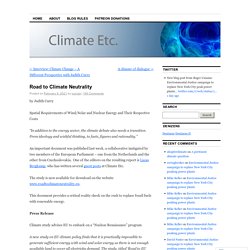
SEAMS Dreams (NOT) – Watts Up With That? Guest post by Rud Istvan, Here we are again on another Charles request, this time just summarizing the essence of several previous related and much more detailed renewables dissections at Climate Etc.
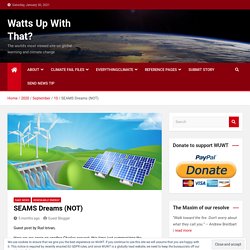
Those previous posts were co-authored with electric utility ‘Planning Engineer’– (who after his recent retirement is invited to comment on this here also). The specific issue Charles highlighted for possible comment was a newish article at the ‘irrefutable’ Atlantic. Bright Green Impossibilities – Watts Up With That? Guest Post by Willis Eschenbach After reading some information at Friends of Science, I got to thinking about how impossible it will be for us to do what so many people are demanding that we do.
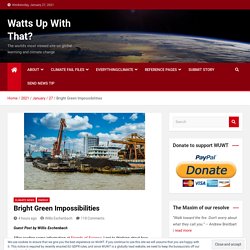
This is to go to zero CO2 emissions by 2050 by getting off of fossil fuels. So let’s take a look at the size of the problem. People generally have little idea just how much energy we get from fossil fuels. Figure 1 shows the global annual total and fossil energy consumption from 1880 to 2019, and extensions of both trends to the year 2050. Figure 1. So if we are going to zero emissions by 2050, we will need to replace about 193 petawatt-hours (1015 watt-hours) of fossil fuel energy per year. About Those ‘Green Energy’ Unicorns… Reposted with permission from The Pipeline You think those baby unicorns grow on trees?
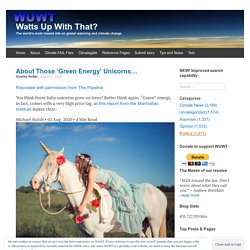
Better think again. “Green” energy, in fact, comes with a very high price tag. as this report from the Manhattan Institute makes clear: Solar and Wind Energy Underestimated? Not. The first part of this post is a report that the IEA is accused of underestimating the amount of solar and wind power in recent years.
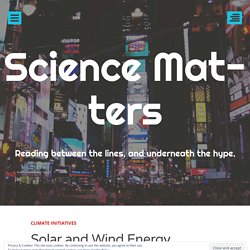
The second part presents analyses showing that media hype and misinformation lead the public to routinely overestimate the portion solar and wind contribute to power modern societies. The IEA is under pressure about their wind and solar energy numbers, as reported at energypost.eu World Energy Outlook 2020: IEA responds to some difficult questions. The Myth of Glorious Renewables. By Vijay Jayaraj We all love energy solutions that make life better.
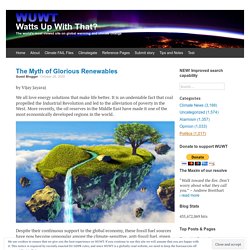
It is an undeniable fact that coal propelled the Industrial Revolution and led to the alleviation of poverty in the West. More recently, the oil reserves in the Middle East have made it one of the most economically developed regions in the world. The Futility of “Renewable” Energy in Two Easy Charts. Guest “energy transition… pft!”
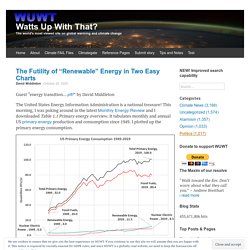
By David Middleton The United States Energy Information Administration is a national treasure! This morning, I was poking around in the latest Monthly Energy Review and I downloaded Table 1.1 Primary energy overview. It tabulates monthly and annual US primary energy production and consumption since 1949. I plotted up the primary energy consumption. “Renewable energy” includes hydroelectric, wind and solar power. Democrat Joe Biden’s remark that he would “transition” away from oil in the U.S. in favor of renewable energy drew quick attention Thursday night from President Donald Trump, who saw it as a boon to his election chances in key states.
Despite an “investment” of about $380 billion from 2004-2015, “renewable” energy consumption only increased by 3.6 quadrillion BTU. If it was actually possible to replace fossil fuels with “renewables,” at $105.56/mmBTU, it would cost just under $8.5 trillion to replace 80.4 quadrillion BTU of fossil fuels. Burning Stuff is so 16th Century. Energy Returned On Energy Invested: Real(ish)Things That Don’t Matter, Part Trois. Why Renewables Can’t Save the Planet. When I was a boy, my parents would sometimes take my sister and me camping in the desert. A lot of people think deserts are empty, but my parents taught us to see the wildlife all around us, including hawks, eagles, and tortoises. After college, I moved to California to work on environmental campaigns. I helped save the state’s last ancient redwood forest and blocked a proposed radioactive waste repository set for the desert. In 2002, shortly after I turned 30, I decided I wanted to dedicate myself to addressing climate change.
I was worried that global warming would end up destroying many of the natural environments that people had worked so hard to protect. I thought the solutions were pretty straightforward: solar panels on every roof, electric cars in every driveway, etc. Our efforts paid off in 2007 when then-presidential candidate Barack Obama embraced our vision. ERoEI for Beginners. The Energy Return on Energy Invested (ERoEI or EROI) of any energy gathering system is a measure of that system’s efficiency.
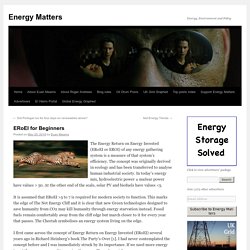
The concept was originally derived in ecology and has been transferred to analyse human industrial society. In today’s energy mix, hydroelectric power ± nuclear power have values > 50. Can We Rely on Wind and Solar Energy? Finally, Some Critical Thinking On The Subject Of The Feasibility Of Renewables — Manhattan Contrarian.
If you are interested in the question of whether it makes sense to try to eliminate fossil fuels from the electricity production system, you are undoubtedly frustrated, as I am, by the astounding absence of critical thinking coming from almost everybody who writes about this subject.
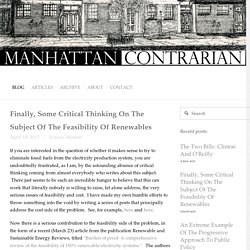
Can wind and solar replace fossil fuels? By Richard D.
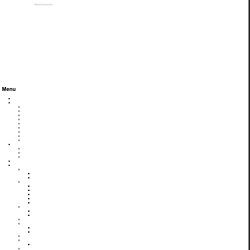
Patton Statements implying that wind and solar can provide 50% of the power to the grid are not difficult to find on the internet. For example, Andrew Cuomo announced that “The Clean Energy Standard will require 50 percent of New York’s electricity to come from renewable energy sources like wind and solar by 2030…” Considering that the wind is erratic, and the solar cells only put out full power 6 hours per day, it seems a remarkable statement.
For some answers, we turn to Germany, which has some of the highest electric bills in the world as well as a high proportion of its electric power produced by wind and solar (19%). As you can see, the power generation (black line), especially after 2011, has been rising, but the power consumption (blue line) has been falling slightly. The table below shows what happened more clearly. Between 2001 and 2011, wind and solar generation rose 57.7 billion kwh. Stability Problems, an example Sources. Peter Foster: Bill Gates, defying the Climate Barons, tells the ugly truth about renewables. Market advocates have always claimed that policy advice from business should be treated with suspicion. The road to economic and political hell is paved with corporate welfare and national champions (SNC-Lavalin anyone?).
Communists and the “progressive” left were much more harsh, claiming that since big business sought only monopoly and plutocracy, the state at least required “countervailing” power, if not absolute power. Since command of economic resources was deemed synonymous with political power, some of the greatest businessmen and philanthropists all time — such as John D. Rockefeller, Andrew Carnegie and Cornelius Vanderbilt — were reflexively dubbed “Robber Barons.” Shocker: Top Google Engineers Say Renewable Energy ‘Simply won’t work’ Guest essay by Eric Worrall A research effort by Google corporation to make renewable energy viable has been a complete failure, according to the scientists who led the programme. After 4 years of effort, their conclusion is that renewable energy “simply won’t work”. According to an interview with the engineers, published in IEEE; “At the start of RE<C, we had shared the attitude of many stalwart environmentalists: We felt that with steady improvements to today’s renewable energy technologies, our society could stave off catastrophic climate change.
We now know that to be a false hope … Renewable energy technologies simply won’t work; we need a fundamentally different approach.” There is simply no getout clause for renewables supporters. Google Engineers Explain Why They Stopped R&D in Renewable Energy. In 2007, when Google unveiled its initiative to make renewable energy competitive with coal, called RE<C, it represented a major breakthrough for the industry. The tech giant said it was prepared to invest tens of millions of dollars to boost emerging solar, wind and geothermal technologies in order to rival the economics of coal. The initiative was unprecedented for a company of its type and put it in the same league with GE, which had undertaken its own ambitious multi-billion-dollar effort years earlier, ecomagination, to commercialize emerging clean energy technologies. Then, in 2011, Google stopped its R&D efforts prematurely. Gates on renewables: How would Tokyo survive a 3 day typhoon with unreliable energy?
Bill Gates: “We need a [energy] miracle” James Hansen Smacks Renewable Energy ("The Easter Bunny and Tooth Fairy"-and Lovins as dreamer) - Master Resource. “Suggesting that renewables will let us phase rapidly off fossil fuels in the United States, China, India, or the world as a whole is almost the equivalent of believing in the Easter Bunny and Tooth Fairy.”
Climate and energy alarmists war with reality. Going Dutch: How Not to Cut Emissions.